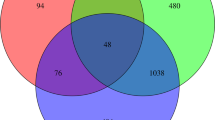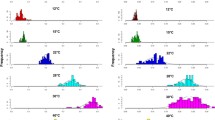Abstract
Acid stress is one of the most common adverse conditions during fermentation of fruit wines, and the acid tolerance of yeasts is, therefore, critical for fruit wine production. However, the biological mechanism underlying the acquired tolerance of yeasts against acid stress is poorly understood. We have previously obtained an evolved Saccharomyces cerevisiae strain ET008-c54 with increased tolerance against acid stress, and potentially, it serves as a promising yeast strain for greengage wine fermentation. In the current study, we further revealed the alterations responsible for the adaptation of ET008-c54 to low pH by whole-genome re-sequencing, transcriptomic, and metabolic analyses. Results confirmed the outstanding fermenting performance of ET008-c54 at low pH as compared with the parental ET008. More specifically, the growth rate of ET008-c54 at low pH was increased by 6.24 times and the fermentation time was shortened by 70%. Differences were also observed in the physiology of the strains through ergosterol, H+-ATPase activity, and aroma determinations. By integrating both RNA-seq and whole-genome re-sequencing data, we demonstrated some metabolic pathways in ET008-c54, namely ergosterol synthesis and ferrous iron uptake, in which several acid-responsive genes were involved being upregulated. Also, upregulation of the pathways responsible for aroma compound formation, including fatty acid ethyl ester synthesis and aromatic amino acid biosynthesis, was identified. Thus, the enhanced fermentation ability of ET008-c54 at low pH should be, at least partly, contributed by the altered gene expressions associated with the aforementioned pathways. By elucidating the biological mechanism of yeasts against acid stress, this current study allows better-defined targets for future studies of genetic improvement of wine yeasts and enhancement of the fermentation processes.
Key points
• Metabolic analysis confirmed the excellent fermentation performance of ET008-c54.
• Acid tolerance genes for ergosterol synthesis and ferrous iron uptake were upregulated.
• Aroma genes for fatty acid ethyl ester and aromatic amino acid synthesis were upregulated.



Similar content being viewed by others
References
Aguilera F, Peinado RA, Millán C, Ortega JM, Mauricio JC (2006) Relationship between ethanol tolerance, H+-ATPase activity and the lipid composition of the plasma membrane in different wine yeast strains. Int J Food Microbiol 110(1):34–42
Anders S, Pyl PT, Huber W (2015) HTSeq-a Python framework to work with high-throughput sequencing data. Bioinformatics 31(2):166–169
Brice C, Sanchez I, Bigey F, Legras JL, Blondin B (2014) A genetic approach of wine yeast fermentation capacity in nitrogen-starvation reveals the key role of nitrogen signaling. BMC Genomics 15(1):495
Byrne KP, Wolfe KH (2005) The yeast gene order browser: combining curated homology and syntenic context reveals gene fate in polyploid species. Genome Res 15(10):1456–1461
Cordente AG, Curtin CD, Varela C, Pretorius IS (2012) Flavour-active wine yeasts. Appl Microbiol Biotechnol 96(3):601–618
De Melo HF, Bonini BM, Thevelein J, Simões DA, Morais MA Jr (2010) Physiological and molecular analysis of the stress response of Saccharomyces cerevisiae imposed by strong inorganic acid with implication to industrial fermentations. J Appl Microbiol 109(1):116–127
Dzialo MC, Park R, Steensels J, Lievens B, Verstrepen KJ (2017) Physiology, ecology and industrial applications of aroma formation in yeast. FEMS Microbiol Rev 41:95–128
Fletcher E, Feizi A, Kim S, Siewers V, Nielsen J (2015) RNA-seq analysis of Pichia anomala reveals important mechanisms required for survival at low pH. Microb Cell Factories 14(1):143
Fletcher E, Feizi A, Bisschops MM, Hallström BM, Khoomrung S, Siewers V, Nielsen J (2017) Evolutionary engineering reveals divergent paths when yeast is adapted to different acidic environments. Metab Eng 39:19–28
García-Ríos E, Morard M, Parts L, Liti G, Guillamón JM (2017) The genetic architecture of low-temperature adaptation in the wine yeast Saccharomyces cerevisiae. BMC Genomics 18(1):159
Giorello F, Valera MJ, Martin V, Parada A, Salzman V, Camesasca L, Fariña L, Boido E, Medina K, Dellacassa E, Berna L, Aguilar PS, Mas A, Gaggero C, Carrau F (2019) Genomic and transcriptomic basis of Hanseniaspora vineae’s impact on flavor diversity and wine quality. Appl Environ Microbiol 85(1):e01959–e01918
Hakkaart X, Liu Y, Hulst M, Masoudi A, Peuscher E, Pronk J, Gulik W, Daran-Lapujade P (2020) Physiological responses of Saccharomyces cerevisiae to industrially relevant conditions: slow growth, low pH, and high CO2 levels. Biotechnol Bioeng 117(3):721–735
Ibáñez C, Pérez-Torrado R, Morard M, Toft C, Barrio E, Querol A (2017) RNAseq-based transcriptome comparison of Saccharomyces cerevisiae strains isolated from diverse fermentative environments. Int J Food Microbiol 257:262–270
Liu S, Chang X, Liu X, Shen Z (2016) Effects of pretreatments on anthocyanin composition, phenolics contents and antioxidant capacities during fermentation of hawthorn (Crataegus pinnatifida) drink. Food Chem 212:87–95
Liu M, Xiong LB, Tao X, Liu QH, Wang FQ, Wei DZ (2018) Integrated transcriptome and proteome studies reveal the underlying mechanisms for sterol catabolism and steroid production in Mycobacterium neoaurum. J Agric Food Chem 66(34):9147–9157
Meijnen JP, Randazzo P, Foulquié-Moreno MR, Brink JVD, Vandecruys P, Stojiljkovic M, Dumortier F, Zalar P, Boekhout T, Gunde-Cimerman N, Kokošar J, Štajdohar M, Curk T, Petrovič U, Thevelein JM (2016) Polygenic analysis and targeted improvement of the complex trait of high acetic acid tolerance in the yeast Saccharomyces cerevisiae. Biotechnol Biofuels 9(1):5
Mendes I, Sanchez I, Franco-Duarte R, Camarasa C, Schuller D, Dequin S, Sousa MJ (2017) Integrating transcriptomics and metabolomics for the analysis of the aroma profiles of Saccharomyces cerevisiae strains from diverse origins. BMC Genomics 18(1):455
Mira NP, Henriques SF, Keller G, Teixeira MC, Matos RG, Arraiano CM, Winge DR, Sá-Correia (2011) Identification of a DNA-binding site for the transcription factor Haa1, required for Saccharomyces cerevisiae response to acetic acid stress. Nucleic Acids Res 39(16):6896–6907
Navarro-Tapia E, Nana RK, Querol A, Pérez-Torrado R (2016) Ethanol cellular defense induce unfolded protein response in yeast. Front Microbiol 7:189
Nyanga LK, Nout MJ, Smid EJ, Boekhout T, Zwietering MH (2013) Fermentation characteristics of yeasts isolated from traditionally fermented masau (Ziziphus mauritiana) fruits. Int J Food Microbiol 166(3):426–432
Palma M, Guerreiro JF, Sá-Correia I (2018) Adaptive response and tolerance to acetic acid in Saccharomyces cerevisiae and Zygosaccharomyces bailii: a physiological genomics perspective. Front Microbiol 9:274
Procopio S, Qian F, Becker T (2011) Function and regulation of yeast genes involved in higher alcohol and ester metabolism during beverage fermentation. Eur Food Res Technol 233(5):721–729
Quatrini R, Johnson DB (2018) Microbiomes in extremely acidic environments: functionalities and interactions that allow survival and growth of prokaryotes at low pH. Curr Opin Microbiol 43:139–147
Steyer D, Ambroset C, Brion C, Claudel P, Delobel P, Sanchez I, Erny C, Blondin B, Francis K, Legras JL (2012) QTL mapping of the production of wine aroma compounds by yeast. BMC Genomics 13(1):573
Tian TT, Yang H, Yang F, Li BW, Sun JY, Wu DH, Lu J (2018) Optimization of fermentation conditions and comparison of flavor compounds for three fermented greengage wines. LWT Food Sci Technol 89:542–550
Tian TT, Wu DH, Ng CT, Yang H, Sun JY, Liu JM, Lu J (2020) A multiple-step strategy for screening Saccharomyces cerevisiae strains with improved acid tolerance and aroma profiles. Appl Microbiol Biotechnol 104:3097–3107
Trapnell C, Williams BA, Pertea G, Mortazavi A, Kwan G, Baren MJV, Salzberg SL, Wold BJ, Pachter L (2010) Transcript assembly and quantification by RNA-Seq reveals unannotated transcripts and isoform switching during cell differentiation. Nat Biotechnol 28(5):511–515
Varela C, Schmidt SA, Borneman AR, Pang CNI, Krömerx JO, Khan A, Song XM, Hodson MP, Solomon M, Mayr CM, Hines W, Pretorius IS, Baker MS, Roessner U, Mercurio M, Henschke PA, Wilkins MR, Chambers PJ (2018) Systems-based approaches enable identification of gene targets which improve the flavour profile of low-ethanol wine yeast strains. Metab Eng 49:178–191
Verstrepen KJ, Van Laere SD, Vanderhaegen BM, Derdelinckx G, Dufour JP, Pretorius IS, Winderickx J, Thevelein JM, Delvaux FR (2003) Expression levels of the yeast alcohol acetyltransferase genes ATF1, Lg-ATF1, and ATF2 control the formation of a broad range of volatile esters. Appl Environ Microbiol 69(9):5228–5237
Wu J, Chen XL, Cai LJ, Tang LT, Liu LM (2015) Transcription factors Asg1p and Hal9p regulate pH homeostasis in Candida glabrata. Front Microbiol 6:843
Zhu XL, Zou SS, Li YB, Liang YH (2017) Transcriptomic analysis of Saccharomyces cerevisiae upon honokiol treatment. Res Microbiol 168(7):626–635
Funding
This work was supported by the National Natural Science Foundation of China (grant number 31701588), the Natural Science Foundation of Jiangsu Province (grant number BK20170178), the Fundamental Research Funds for the Central Universities (grant number JUSRP11965 and JUSRP21914), and the Program of Introducing Talents of Discipline to Universities (111 Project) (111-2-06).
Author information
Authors and Affiliations
Contributions
TT, DW, and JL conceived and designed research. TT, HY, and JL conducted experiments. TT and JS analyzed data. TT and CN wrote the manuscript. All authors read and approved the manuscript.
Corresponding authors
Ethics declarations
Ethical statement
This article does not contain any studies with human participants or animals performed by any of the authors.
Conflict of interest
The authors declare that they have no conflict of interest.
Additional information
Publisher’s note
Springer Nature remains neutral with regard to jurisdictional claims in published maps and institutional affiliations.
Electronic supplementary material
ESM 1
(XLSX 375 kb)
Rights and permissions
About this article
Cite this article
Tian, T., Wu, D., Ng, CT. et al. Uncovering mechanisms of greengage wine fermentation against acidic stress via genomic, transcriptomic, and metabolic analyses of Saccharomyces cerevisiae. Appl Microbiol Biotechnol 104, 7619–7629 (2020). https://doi.org/10.1007/s00253-020-10772-z
Received:
Revised:
Accepted:
Published:
Issue Date:
DOI: https://doi.org/10.1007/s00253-020-10772-z




